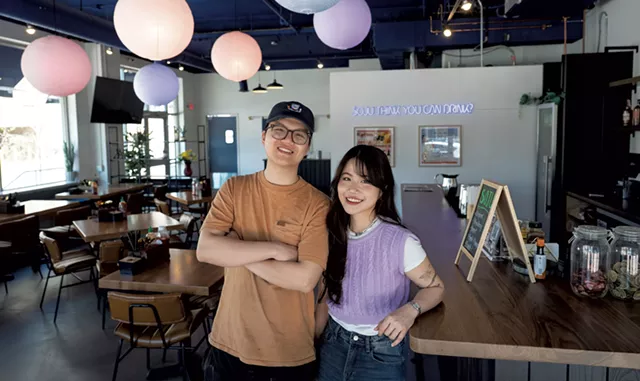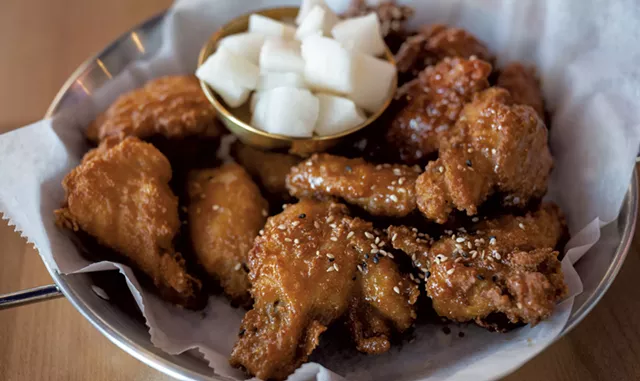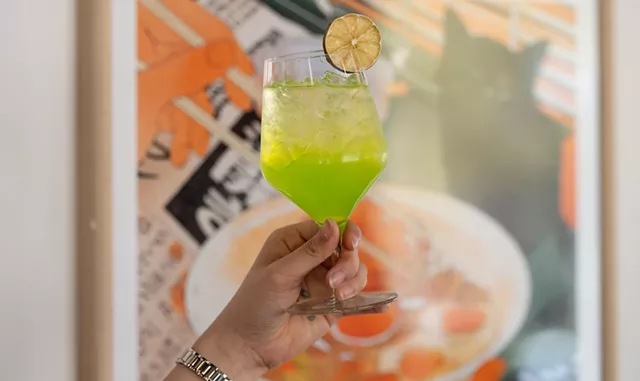Summer Cao has never been to Korea. But that didn’t stop the driven young entrepreneur from launching Donwoori Korean restaurant in South Burlington in late 2023. Cao, now 26, was born in Vietnam and worked at several Korean restaurants to pay her way through university in Australia. She moved to Vermont in 2022 with her younger brother, Khoi, to join their mother, Vicky Le.
In the U.S., Summer worked days at a bank and evenings at Mandarin restaurant in Winooski while she strategized how to become her own boss. Seeing a gap in the Burlington-area dining scene for Korean food — including its supremely crispy, often sticky-sauced fried chicken — she decided to fill it.
“I took a leap,” Summer said, noting that her original spot on Williston Road — a small, mostly takeout business — didn’t require much capital to launch. She named the restaurant with Korean words that sound like “don’t worry” to an English speaker’s ear — perhaps a reminder to herself as well as her customers.
“The only thing I had to lose was time, and, being in my early twenties, all I had was time,” Summer said.
About a year after Summer opened Donwoori with the help of her brother, the siblings took a bigger and far more expensive leap. They’re now business partners in a 34-seat restaurant on Winooski Falls Way, less than a block from their mom’s Champlain Nails salon.
“I’d been eyeing this place even before opening the other location,” Summer said. “We live in Winooski, too, so we’re very familiar with the neighborhood.”
The new Donwoori is also around the corner from Community College of Vermont, where Khoi, a 21-year-old Reserve Officers’ Training Corps cadet, is studying restaurant management.
Khoi admitted with a shy smile that he’s probably learning as much about his college major at Donwoori as he is in the classroom. Summer said her brother is invaluable to the business: “He’s the only other person I can rely on besides myself.”
After major renovations, which took almost three months longer than planned, the new Donwoori opened on March 18. The lunch and dinner restaurant has already generated buzz for its fun ambience; creative cocktails made with soju, a popular neutral spirit in Korea; and dishes flavored with gochujang, the fermented chile paste that brings the trifecta of heat, umami and sweetness to Korean cuisine.
Donwoori’s dining room feels poised for a celebration. Framed artwork brightens the room, and a long wooden bar leads to a neon sign teasing, “Soju think you can drink?” Stylish cushioned chairs ring the tables. Large paper globe-shaded lights float from the high ceiling. Summer enthusiastically demonstrated during an interview how she can use her phone to change the pastel tints of their bulbs.
Summer said she always expected the South Burlington location to be a stepping stone to bigger things, but it happened more quickly than she anticipated. With only eight seats, the original Donwoori built a brisk, mostly takeout business driven by its crunchy, double-fried chicken wings coated in sweet, tangy and spicy glazes, ranging from maple-gochujang to mango-sriracha.
But the tight quarters limited both sales and staff, obliging Summer to wear too many hats and overextending her attention. “It was better to scale up,” she said.
The Winooski restaurant had been open only a couple of weeks when I first dropped by for takeout. The place was impressively busy for 6 p.m. on a Tuesday, and I took a stroll along the river while waiting for my fried mandu dumplings ($7.50 for five) and japchae noodles with vegetables ($13).
I resisted gobbling a dumpling on the 10-minute drive home, even though I feared the wait would ruin their texture. Happily, when I opened my order, I saw that a section of the container lid had been carefully cut out, preventing trapped steam from sogging their crisp skins. I crunched them down, relishing the light filling of ground pork, veggies and glass noodles made even more savory by frequent dips into a vinegary, soy-based sauce. I easily could have eaten another five.
Those same translucent sweet potato noodles tangled with an abundant garden of vegetables in my main dish. The pleasantly slippery strands and tender veggies were deeply seasoned and topped with sunny, slender ribbons of omelette. Even tumbled into a takeout container, the japchae was appealingly colorful.
Summer said the Donwoori team pays attention to details, such as the lid venting and food presentation, whether the order is takeout or dine-in. “It doesn’t matter how tasty your food is if it wasn’t presented well,” she said.
But takeout can never quite match a dine-in experience, which I returned to try on a recent Tuesday evening. My group of four was lucky enough to snag a table around 6:15, before the rush. Our dinner got off to a slow start due to short staffing, but after a wait to order and for our drinks, the food arrived promptly.
My three friends readily volunteered to test the alluring list of cocktails, which Summer designed to feature soju and to complement the menu’s fried food. Donwoori also offers 375-milliliter bottles of lower-alcohol soju ($17 to $19) in flavors from strawberry to yogurt, which she said are popular with young Koreans.
The cocktail trio was beautiful and well balanced, especially the luminously green matcha melon highball ($11), made with soju, Midori melon liqueur, matcha-lime cordial and lime; and the garnet-toned Spice for the Seoul ($13), with soju, ginger liqueur, honey, lime, cinnamon and green tea.
We began with a few fried appetizers, of which the wings were the standout. A regular order ($16 for nine to 10 wings) allows for two sauce choices. My table favored the more savory soy-garlic over the sweeter maple-gochujang. The wings were satisfyingly crisp, which Summer attributed to a multistep technique and careful sauce viscosity management. Every order comes with a small bowl of tangy-sweet, house-pickled daikon radish, a perfect foil for their richness.
I learned later that we could have requested our wings spicier and that the Cao siblings’ favorite flavor is honey butter. Summer described it temptingly as those two ingredients cooked down with a splash of soy to a “thick, glossy consistency almost like caramel.” Yes, please.
Each of the five mains we shared family-style was distinctly different and earned its own superlative, though the mandu and japchae from my inaugural takeout order remain my “most likely to repeat” dishes.
Tteokbokki ($11), with optional cheese at the recommendation of our server, topped the “most reminiscent of an all-American childhood” category — with a decidedly Korean twist. The chewy rice cakes resemble short string cheeses in appearance, though their texture has a very different bounce. One of my dining companions noted that the sweet, tomatoey sauce gave him a “SpaghettiOs vibe in a good way,” with a spicy kick. The sausages in the mix recalled fat cocktail wieners, and the optional double hit of melted American and shredded cheddar cheese rang other Proustian bells.
A runner-up in that category might be the kimchi fried rice ($13) with optional Spam, a South Korean staple that was introduced via the U.S. Army during the Korean War. (“They love their Spam,” Summer said.) Our server missed my request for the Spam, but I tasted it later and can vouch for the added value of those salty, fatty pink cubes sprinkled through the fried rice, which comes with a comforting fried egg on top.
For “best supporting performance by crunch,” the curry udon noodles with the chicken katsu option ($19) ranked high. Audibly crunchy bites of panko-crusted and fried chicken cutlet, drizzled with a katsu sauce made with soy, brown sugar, mirin and a touch of tomato, offered just the right contrast to the squishy noodles in mellow curry.
Bibimbap, which we ordered topped with fried tofu ($16), earned the prize for “prettiest dish you hate to dig into” with its neat mounds of tofu, mushrooms, carrots, cucumber and zucchini orbiting a bright-yolked fried egg on a bed of rice. It comes with a side of kimchi; a thick, gochujang-based sauce; and the instruction to toss everything before digging in. Once we did so, one of my well-traveled friends said, “It brought me back to Seoul.”
Finally, our order of beef bulgogi ($16) delivered in the “not fried but still delicious” category. Alternating bites of white rice with grilled, marinated, thinly sliced steak, onions and carrots, all wrapped with a spoonful of kimchi in lettuce, felt almost like a health-food chaser to our meal.
In the “what the owners eat” contest, Khoi said his go-to order is japchae noodles topped with beef bulgogi ($16). Summer picks bibimbap with spicy pork ($18). But the restaurateur admitted she is so busy running the business that she often forgets to eat.
Luckily, Mom is nearby. “She comes, like, twice a day just to check on us and make sure we eat,” Summer said.
Sometimes Le even brings homemade soup to her restaurant-owner kids. “Mom-cooked food”: the best category there is.



